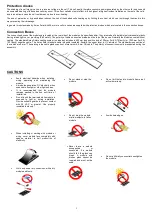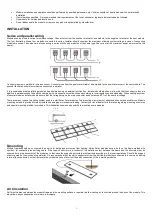
1
KORAX SOLAR
General installation guide for Korax Solar photovoltaic modules
INTRODUCTION
This guide contains application and safety information with which you should be familiar before using your Korax Solar photovoltaic module. Your
authorized Korax Solar distributor or dealer can provide additional sizing and system design information if necessary.
The information in this guide is based on Korax solar knowledge and experience and is believed to be reliable, but such information including product
specifications and suggestions do not constitute a warranty, expressed or implied. Korax solar reserves the right to make changes to the product
specifications, or guide without prior notice.
GENERAL INFORMATION
The installation of modules requires a great degree of skills and should (if DC voltage exceeds 100 V then must) only be performed by qualified licensed
professional, including licensed contractors and licensed electricians. The installer assumes the risk of all injury that might occur during installation,
including the risk of electrical shock.
Korax Solar photovoltaic modules do not require the use of special cable assemblies. All modules come with a permanently attached junction box that
will accept a variety of wiring applications or with a special cable assembly for ease of installation.
It is recommended to utilize qualified installer or reseller for service.
WARNING
All instructions should be read and understood before attempting to install, wire, operate, and maintain the module. Contact with electrically active parts
of the module such as terminals can result in burns, sparks, and lethal shock whether the module is connected or disconnected.
Modules produce electricity when sunlight or other sources illuminate the module is not considered a shock hazard. When modules are connected in
series, voltages are additive. When modules are connected in parallel, current is additive. Consequently, a multi module system can produce high
voltages and current, which constitute an increased hazard and could cause serious injury or death.
TECHNICAL INFORMATION
The Korax Solar photovoltaic modules use high efficiency pseudo-square monocrystalline (or square polycrystalline) silicon cells to turn solar radiation
energy into direct current electric current. The cell circuit is laminated using ethylene-vinyl acetate (EVA) as a capsulant, in an assembly formed by a
tempered glass at its front and plastic polymer (Tedlar) at the rear, which provides resistance against environmental agents and electric insulation.
The laminate fits into an anodised aluminium structure. The IP-65 protected terminal boxes are made from temperature resistant plastic and contains
terminals, connection terminals and protection diodes (by-pass diodes). The frame has several fasting holes for securing the module to the support
structure and its earthing, if necessary.
Section of a photovoltaic module.
The electrical values are obtained under standard testing conditions (STC) which correspond to a 1000 W/m
2
irradiance, 1,5 AM (air-mass) spectrum
and 25
o
C cell temperature. However, the actual working conditions of the modules, once they are installed may be different from the laboratory
conditions. Therefore it is advisable to check out the actual local conditions in order to carry out the pertinent corrections in calculation.
Under actual conditions, a photovoltaic module may experience higher than standard illumination and produce more current and voltage than reported at
STC conditions. Accordingly the values of Isc and Voc should be multiplied by a factor of 1.25 when determining the voltage ratings, conductor
capacities, fuse sizes, and sizes of controls connected to the module output.






















